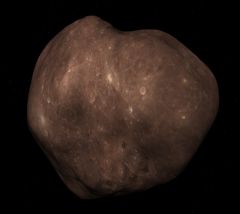Difference between revisions of "3200 Phaethon"
(Created page.) Tag: Removed redirect |
(Corrected name.) |
||
| (2 intermediate revisions by the same user not shown) | |||
| Line 2: | Line 2: | ||
!bgcolor="lightsteelblue" colspan="2" align="center" |3200 Phaethon | !bgcolor="lightsteelblue" colspan="2" align="center" |3200 Phaethon | ||
|- | |- | ||
| − | |colspan="2" align="center"|[[Image:3200Phaethon- | + | |colspan="2" align="center"|[[Image:3200Phaethon-MercuryCrosser-Orbiter2005P1.jpg|240px]] |
|- | |- | ||
|colspan="2" align="center"|'''Phaethon from ''Mercury_Crosser.zip'' in Orbiter 2005P1''' | |colspan="2" align="center"|'''Phaethon from ''Mercury_Crosser.zip'' in Orbiter 2005P1''' | ||
| Line 51: | Line 51: | ||
'''3200 Phaethon (1983 TB)''' is [[Category:Near-Earth objects|Near-Earth object]] object. It was discovered by [[w:Simon F. Green|Simon Green]] on 11 October 1983 from images from the [[w:IRAS|Infrared Astronomical Satellite (IRAS)]]. | '''3200 Phaethon (1983 TB)''' is [[Category:Near-Earth objects|Near-Earth object]] object. It was discovered by [[w:Simon F. Green|Simon Green]] on 11 October 1983 from images from the [[w:IRAS|Infrared Astronomical Satellite (IRAS)]]. | ||
| − | The orbit of | + | The orbit of Phaethon varies from about 0.14 to 2.4 [[Astronomical unit|AU]], which makes Phaethon cross the orbits of all four of the inner planets. |
Phaethon is about 6.13 km × 4.40 km × 0.06 km, mean radius is about 5.8 km. | Phaethon is about 6.13 km × 4.40 km × 0.06 km, mean radius is about 5.8 km. | ||
| Line 73: | Line 73: | ||
==Gallery== | ==Gallery== | ||
<gallery widths="100" heights="100"> | <gallery widths="100" heights="100"> | ||
| − | 3200Phaethon- | + | 3200Phaethon-MercuryCrosser-Orbiter2005P1.jpg|<center>1566 Icarus from ''Mercury_Crosser.zip'' in Orbiter 2005P1</center> |
PIA22185.gif|<center>Animation of radar images of Pheathon taken on 17 December 2017<br>from Wikimedia Commons</center> | PIA22185.gif|<center>Animation of radar images of Pheathon taken on 17 December 2017<br>from Wikimedia Commons</center> | ||
Animation of 3200 Phaethon orbit.gif|<center>Animation of the orbit of Phaethon compared to the orbits of the inner planets<br>from Wikimedia Commons</center> | Animation of 3200 Phaethon orbit.gif|<center>Animation of the orbit of Phaethon compared to the orbits of the inner planets<br>from Wikimedia Commons</center> | ||
Latest revision as of 03:17, 7 October 2024
3200 Phaethon (1983 TB) is object. It was discovered by Simon Green on 11 October 1983 from images from the Infrared Astronomical Satellite (IRAS).
The orbit of Phaethon varies from about 0.14 to 2.4 AU, which makes Phaethon cross the orbits of all four of the inner planets.
Phaethon is about 6.13 km × 4.40 km × 0.06 km, mean radius is about 5.8 km.
3200 Phaethon in Orbiter[edit]
Phaethon was introduced to Orbiter with the release of Mercury_Crosser.zip in June 2005.
Note that the landing surface as given in the config file is spherical, but the visual of Icarus is not, if you land, you will likely be above or below the visual surface.
| Add-on | Source | Version | Author | Type | Release Date | Compatibility | Wiki article |
|---|---|---|---|---|---|---|---|
| Mercury Crosser Asteroids | O-F Resources | 2005-06-01 | Nighthawke | Scenery | 2 June 2005 | ||
See also[edit]
Gallery[edit]
| edit The Solar System | |
|---|---|
| Central star |
Sun (Sol) |
| Planets |
Mercury - Venus - Earth - Mars - Jupiter - Saturn - Uranus - Neptune |
| Natural satellites |
Moon - Phobos - Deimos - Io - Europa - Ganymede - Titan - more... |
| Add-ons |
Planets - Dwarf Planets - Small objects - Natural satellites - Alternative star systems |



